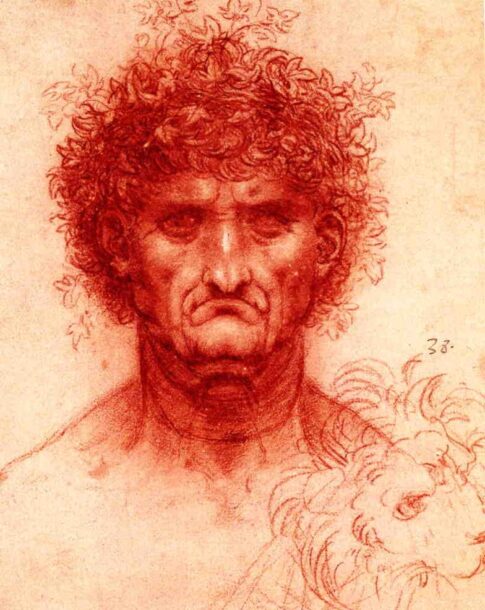
Leonardo Da Vinci (man’s head and Lion, 1519)
“The equivalent of commodity fetishism in the psychological life of the individual is narcissism. Here the term does not only denote adoration of one’s own body or one’s person. It stands for a serious pathological condition well-known to psychoanalysis. An adult preserves the psychological structure of the first years of his childhood, when there is no distinction between the self and the world. Every external object is experienced by the narcissist as a projection of his own self.”
Anselm Jappe (The Writing on the Wall)
“No one should underestimate the dangers of courting the displeasure of a savage and jealous God.”
Andrew Scull (Madness in Civilization)
“To lull public attention, the King was said to suffer from dropsy. Afterward, reports as to the misadventures incurred by him in his own gardens at Sans Souci, sometimes hurting an eye against a tree, at other times damaging a leg on a stone, became more and more frequent, and, as early as the beginning of 1856, it was insinuated here and there, that he labored under temporary attacks of insanity. It was more especially said that he fancied he was a non-commissioned officer, who had still to pass through the trial of what, in the technical language of the Prussian drill- sergeant, is called Übungsmarsche. Thence he used to run ill-omened races by himself in his parks at Sans Souci and Charlottenburg. These and other reminiscences of a period of ten years are now being carefully connected. Why, it is asked, should not all that time an insane have been palmed off as King upon the Prussian people, since it is now confessed that for the last eighteen months at least Frederick William IV was kept on the throne despite his mental disease, and since, consequent upon the quarrels among the members of the royal family, the juggles played in his name by the Queen and the Ministers have been publicly exposed.”
Karl Marx (King of Prussia, Insanity. New York Daily Tribune, 1858)
“The small vessel leads to the larger, and as man finds himself in a state of desolation, anguished sentiments, temptations, images and misery in all forms rise up within him.”
Johann Tauler (Predigten, 1300-1361)
“Two traits are essential in the criminal: boundless egoism and a strong destructive impulse. Common to both of these, and a necessary condition for their expression, is the absence of love, the lack of an emotional valuation of (human) objects.”
Sigmund Freud (Dostoyevsky and Parricide)
I have noted, recently, how exaggerated has become the role and image of science throughout the West today. And I have, I admit, ambivalent feelings about science. And this ambivalence comes from the undeniable elevation society and western culture (what’s left of it) give, in an almost cultic manner, to ‘science’ — but also one cannot ignore the undeniable achievements of science today. And it is hard, when being critical of science not to find oneself in bed (so to speak) with irrationalists and crack pots. When Covid hit (if it did, or the Flu hit, or whatever), and many of us immediately suspected the fraud and misinformation, the authoritarian trial balloons sent up vis a vis lockdowns and protocols, we also found ourselves aligned with people who argued viruses (as an example) didn’t exist. And this was, in a sense, the lesson of the Covid story: government propaganda, hitched to draconian social policy, was going to muddy the waters of rational reasonable thought. Overall, science has achieved remarkable things, but it has also, perhaps, reached a point of diminishing returns. And maybe more, the achievements need to be reconsidered. This is the civilizational epoch of ‘capitalism’. Everything is shaped by capitalism. There is no escape from it. And capitalism has a complex but inexplicable relation to science.
Now, this has been written about for a hundred years, longer ….one hundred and fifty years… and no doubt longer than that in some respects. But I wanted to try to look how it is now affecting daily life in an era where clearly (I believe) it is in crisis. Capitalism feels as if is dying. And this is tied to science via automation and surveillance and growing (almost impossibly) inequality. The post work future. Now I happen to believe that technology has reached a point of diminishing returns, too. I do not believe technology, as it is constituted today, is sustainable. And usually when this topic is raised it is raised in the shadow of ‘Climate Change’. But I don’t believe in man made climate change. I think the earth may be warming, in places at least, but its not the result of fossil fuels and greenhouse gases. I think ‘if’ earth is warming it is the result of natural (cosmic) cycles and the Sun, etc. But I do think pollution is a massive factor that is killing natural habitat, poisoning humans, and destroying eco-systems. One of the arguments against man made climate change is that so few climate alarmists feature militarism in their arguments. And here one begins to wonder if all the ‘achievements’ of science since, say, the Industrial Revolution were actually achievements at all. Some feel harder to argue against than others, but in total I am haunted by the idea that science is so deeply flawed, at least under capitalism (and that is a spurious hypothetical to which I will return) that humankind might well have been less miserable without it.

Lorna Simpson
The U.S. spends 892 billion dollars a year on defense. The U.S. is a war machine. That is essentially all that it does. It manufactures war and murder. Now this has all been written about, as I say, for decades. But society today, at least in the West, is suffering what others have called a ‘mental health crisis’. And THAT is what does interest me here. Suicide rates in the U.S. increased 30% between 2002 and 2022. It increased the most for women, but suicide among men was still three to four times higher than that of females. Poverty is acute in the U.S., and a third of all children live below the poverty line.
The use of anti depressants keeps growing. As do figures for self harm and drug addiction. But statistics can be unreliable and tend not to offer a very nuanced picture. Mental health itself is a hugely contested term. If you are an addict, does that mean you are de-facto suffering mental health issues? What does it mean to be happy or sad? Have humans always been this miserable?
I wrote a couple of times in recent posts about the ‘narrative’ of quantum physics. And this feeling keeps nagging at me that there is a crucial truth about quantum theory, about the fact (if thats the word) that the answer is always only probabilities. And this seems to be true in terms of much post internet computer science. Quantum theory is not new, and in fact little if anything of significance has occurred in quantum theory for the past forty or fifty years. Still, this feels like ‘the age of probabilities’. The probabilistic is the new mythology.
But I have to back up here a little bit. Because Quantum Mechanics doesn’t actually directly even refer to probability. But then in some sense classical mechanics, Newtonian physics, also employs a degree of probability. And this is always a problem with any ‘measurement’. Hence an entire theory and field titled ‘The Measurement Problem’. But never mind, I have written on this stuff before. What interests me is the misery of daily life in the West, coupled to mental health (and deciding what that means) and the death throws of western capitalism (if what we are seeing is, in fact, death throws). And this segues directly to education and Academia. Its not possible for me to be more jaundiced at this point regards institutional academics. But while scrolling around for info on ‘probability’ I was reminded of the existence of The Sante Fe Institute (originally called The Rio Grande Institute, which is a much better name and sounds like a John Ford movie).
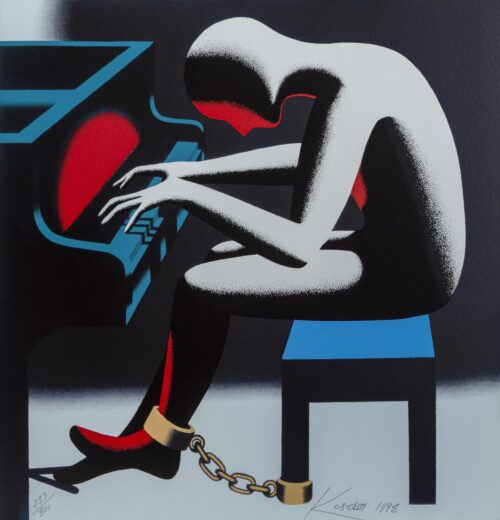
Mark Kostabi
Here is one of the online courses (sic) the Institute offers https://www.santafe.edu/engage/learn/programs/economics-short-course
Note the course description. Note also there is nothing identifying the two men seated there.Never mind, it was ten years ago. But here is what they study https://www.santafe.edu/about/overview
One course is titled “Evolution and Time Horizons in an Agent-Based Stock Market”. What might this be about you ask? Well, I can tell you….“Recent research has shown the importance of time horizons in models of learning in finance. The dynamics of how agents adjust to believe that the world around them is stationary may be just as crucial in the convergence to a rational expectations equilibrium as getting parameters and model specifications correct in the learning process. This paper explores the process of this evolution in learning and time horizons in a simple agent-based financial market.”
Well, Ok, that’s an old one, too. In fact it’s from 2001. The most recent info I found was this https://www.santafenewmexican.com/life/features/santa-fe-institute-game-theory-course-takes-on-real-life-scenarios/article_b78e366e-eb74-5809-9df5-824d7ce49b48.html#:~:text=The%20Santa%20Fe%20Institute’s%20online%20Complexity%20Explorer,mostly%20free%20classes%2C%20students%20eventually%20will%20have
My mind starts to shut down at exactly this point. This is not serious stuff, this is academic junk science. Game theory has always been a hustle (like playing bass in a rock band), and if you have guys like this (all of 28 years old) telling you everything in life is a game, I want to run naked down the street screaming and tearing the flesh from my face.

Celine and French actress Arletty, Meudon, France 1958
Here is a quote from the above interview “Grana’s research centers, at the moment, on the game theory of cybersecurity. There is, he said, the basic game: An attacker who wants to penetrate a cybernetwork, and a defender who wants to protect its data and information.” Now why is game theory even mentioned. Its a study of security options, hypothetical scenarios if attacked, as has been practiced for THOUSANDS OF FUCKING YEARS. The builders of the Great Wall of China were doing this.
But I suggested a couple blog posts back that quantum physics, from a cultural perspective, was the necessary science for advanced capitalism, the Sixties and the anti communism of the U.S. government. It was to science what LSD was to culture.
Well, Lambert Williams is saying something closely related, it turns out.
“The other account of the institute is contained in historian of science Lambert Williams’ PhD thesis, entitled ‘Modeling, Building, Writing: A History of Nonlinear Dynamics and Complex Systems’. By telling together the history of chaos theory and of complexity sciences, Williams has claimed that “the popular science genre [is] something constitutive of fields, and not just post-facto vehicles for reporting on them.” In this sense “literary strategies (…) helped to manufacture chaos and complexity science. According to him, complexity science is a quasi discipline, not a full one.”
Fabrizio li Vigni (The failed institutionalization of “complexity science:” A focus on the Santa Fe Institute’s legitimization strategy)
This is quite brilliant, in my opinion. The popular science genre, which itself has complex tiers of ideological meaning, invents fields of study — well, of ‘science’. The attempt to make quantum theory accessible, to some degree, but also chaos theory, which came directly from Edward Lorenz’s work in the 1960s (see *the butterfly effect*, a perfect sixties idea of interconnectedness ….pass the spliff, dude) resulted in a generalized idea of complexity — hardly a new idea — but now given a title: ‘complex systems theory’.
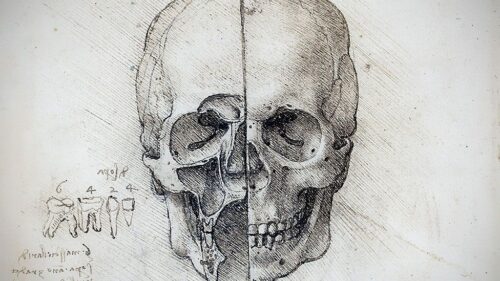
Leonardo Da Vinci
There are several histories out there on the Santa Fe Institute. It almost goes without saying that the defense industry is one of the donors and that companies and individuals from the Silicon Valley network are involved, as well as big corporate donors like Morgan Stanley and Volvo, and the ubiquitous Pierre Omidyar (who funded directly many of the scholarships and prizes). One of the goals of the SFI was to legitimize the SFI, and to sell ‘complexity’ (and adjacent disciplines…sic) as legitimate. The entire project feels like a marketing exercise. And to be clear, almost nothing of any significance has come out of the SFI.
But ‘prediction’ is a hallmark of the surveillance state. Prediction itself is paranoid. Today of course western society is introducing ‘pre crime’ ideas. Philip K. Dick wrote of this, in sci fi novels, fifty years ago. Future crime or pre-crime is just an updated colonial system designed to punish the poor. It is also a building block of the new science mythology. And ‘chaos theory’, a primary tool in climate discourse. It is almost ‘the’ core tool for computer modelling of the weather. Will El Nino grow stronger or die ? So computer geeks run scenarios where there tinker with the initial computations, and that is even total guesswork because mostly the oceans remain utterly mysterious, and then check how the results have changed. And this sort of theory (sic) is also the hallmark of many quantum experiments in physics. Informed guesswork. And what this will tend to yield is, in policing for example, just fascist subjugation of the populace. In climate it will yeild whatever you want. Short term statistical weather forecasting is relatively accurate, in a general sense, for a few days looking ahead. Dynamical models (not statistical but based on chaos theory) can do no better. In fact they do worse. But then, anything beyond very scaled down local predictions have any value at all. If you are told there is a 65% chance of rain, and that that rain will begin between 11 am and 3 pm, Id suggest not bothering with reading this stuff. But people do, obsessively in fact. And that is because even if the forecast is rarely right, they are participating in the neo-religious ritual of science. It is taking science communion.

Arnold Genthe (photography, autochrome. Grand Canyon, 1906)
And this brings us back to, yet again, the Enlightenment, psychoanalysis, and madness.
“The sinner who abandons the leper to his fate thereby opens the door to his salvation. ‘Thus be patient in your sickness, for the Lord does not underestimate your ills, nor separate you from his company. If you have patience, so shall you be saved, like the leper who died outside the door of the rich man, and was carried straight up to Heaven.’ Abandonment is his salvation, and exclusion offers an unusual form of communion.”
Michel Foucault (History of Madness)
For all his very reactionary politics, Foucault had many rather brilliant insights. Writing about the ‘ship of fools’, an iconic image of the middle ages derived from some European countries policies toward the ‘insane’, that is, putting them in boats and sending them down (or up) river.
“The ship is a symbol of a sudden unease that appears on the horizon of European culture towards the end of the Middle Ages. Madness and the figure of the madman take on a new importance for the ambiguousness of their role: they are both threat and derision, the vertiginous unreason of the world, and the shallow ridiculousness of men. The first thing of interest is a literature of stories and morality tales. Its origins, no doubt, were far distant, but at the end of the Middle Ages it became a considerable mass: a long series of ‘follies’ which as in the past stigmatised vices or faults but blamed them not on pride, a lack of charity or the neglect of Christian virtues but on a great unreason which could be blamed on no one in particular but which dragged everyone along in its wake in a sort of tacit agreement. The denouncing of madness became a general form of moral critique. In farces and soties, the character of the Fool, Idiot or Simpleton took on an ever-greater importance. He was no longer familiar and ridiculous, but exterior to the action, and took centre stage as the harbinger of truth, playing the complementary, inverse role of the figure of the fool in tales and satires.”
Michel Foucault (Ibid)
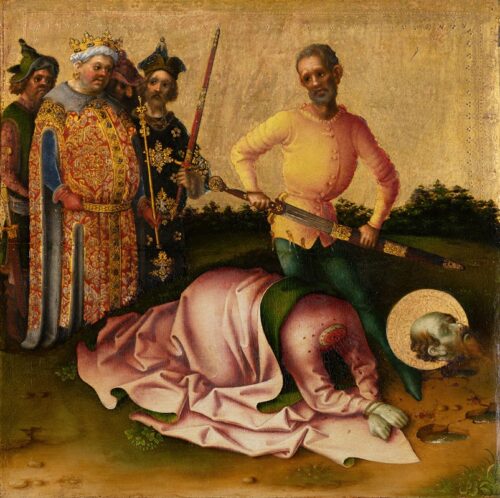
Stefan Lochner (Martyrdom of St Paul, 1435)
But more importantly is the ambivalence of curiosity, of secret knowledge. For that is temptation. And this is represented by untamed and undomesticated nature.
“The animal realm has moved out of range of all domesticating human symbolism, and while it fascinates mankind with its disorder, its fury and its plethora of monstrous impossibilities, it also serves to reveal the dark rage and sterile folly that lurks in the heart of mankind. At the opposite pole to this nature of darkness, madness also exerts a fascination because it is knowledge. And that is because these absurd figures are in reality the elements that make up a difficult, hermetic, esoteric knowledge. These strange forms belong from the outset to the great secret, and Saint Anthony is tempted by them because he has fallen prey not to the violence of desire but rather to the far more insidious vice of curiosity, tempted by the lure of this knowledge which is just beyond his reach, offered and withdrawn at the same instant by the smile on the face of the gryllos.”
Michel Foucault (Ibid)
This is the very front edges of an intuitive terror, or forces we cannot see. The dark rage of wild beasts is just a projection, of course, of our own homicidal urges. Violence always resides just next door to purity. The torture chamber is below the monasterial cell. But this is the question, really. Were the people of the 12th century, the 13th, the 15th, neurotic in the sense of Vienna in the 1890s, or Chicago in 2025? There was no shortage of violence, certainly but one senses the violence was of a different character. I cannot quite tell what I mean by that, except that I suspect it was about God and less about ‘me’.

Stephen Westfall
“Madness is no longer the familiar strangeness of the world, but a spectacle well known to the observer from outside; not a figure of the cosmos, but merely of the order of the aevum.”
Michel Foucault (Ibid)
Aevum is a useful term here. It means a special specific experience of duration (as it was usually used in the time of Erasmus) — between eternity and daily time, an era of temporality that suggests fate and destiny. It is time experienced by angels and saints. It is exactly such a word that ‘science’ got rid of.
There was much debate about the end of the world in the later middle ages. There is much debate about today about the end of the world, from global warming or rising seas, or ocean acidification. In some sense, theories such as The Big Bang feel bloodless and un-evocative compared to the origin stories of ancient civilisations.
“This conflict between critical consciousness and tragic experience underlies all that was felt and formulated on the theme of madness at the beginning of the Renaissance. { } In short, the critical consciousness of madness was increasingly brought out into the light, while its more tragic components retreated ever further into the shadows, soon to almost vanish entirely. Only much later can a trace of the tragic element be again discerned, and a few pages in Sade and the work of Goya bear witness to the fact that this disappearance was merely an eclipse; the dark, tragic experience lived on in dreams and in the dark night of thoughts, and what happened in the sixteenth century was not a radical destruction but a mere occultation. The cosmic, tragic experience of madness was hidden by the exclusive privileges of a critical consciousness. { } Behind the critical consciousness of madness in all its philosophical, scientific, moral and medicinal guises lurks a second, tragic consciousness of madness, which has never really gone away. It is that tragic consciousness that is visible in the last words of Nietzsche and the last visions of Van Gogh. It is that same element that Freud began to perceive at the furthest point of his journey, the great wound that he tried to symbolise in the mythological struggle between the libido and the death instinct. And it is that same consciousness that finds expression in the work of Antonin Artaud. If the thinkers of the twentieth century paid more attention, they would find in Artaud’s work one of the most pertinent questions of the age, and whose clutches are the most difficult to escape. Artaud never ceased to claim that Western culture lost its tragic focus the moment it finally forgot what he termed the great solar madness of the world, the violent ceremonies which enacted the life and death of ‘the great Fire Satan’.”
Michel Foucault (Ibid)

R.H. Quaytman
The Artaud comment is quite interesting. And Foucault’s following paragraph is key to the entire book:
“It is only by examining such extreme discoveries that we can finally come to understand that the experience of madness common since the sixteenth century owes its particular face, and the origin of its meaning, to that absence, to that dark night and all that fills it. The linearity that led rationalist thought to consider madness as a form of mental illness must be reinterpreted in a vertical dimension. Only then does it become apparent that each of its incarnations is a more complete, but more perilous masking of tragic experience — an experience that it nonetheless failed to obliterate.”
Michel Foucault (Ibid)
The loss of the tragic becomes neurosis. It is interesting to look at the last existential (and religious) filmmakers, in particular Ingmar Bergman, who made two indelible films about God, or meaning. And to compare The Seventh Seal with Bresson’s Lancelot du Lake; both films about knights returning from the crusades, disillusioned and facing the darkness of post Crusades Europe — in one case, a landscape ravaged by plague. (The other Bergman masterpiece, for me anyway, is Shame (1968). A decade after The Seventh Seal.) But the Knights return, one at the end of his life, the other after absolute failure and spiritual defeat, and ignominy; are both stunning allegories about expectation and a search for meaning and a search for redemption. They come home to the disappearance of societal structure, codes of behaviour, and morality. It occurs to me that these were the last films to be made that were directly about morality.
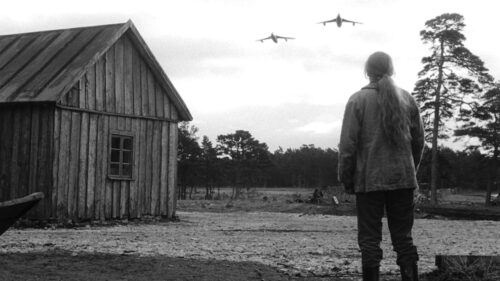
Shame (1968, Ingmar Bergman, dr.)
The medieval understanding of madness was that it was bottomless. The deepest secrets of madness were buried in unfathomable depths — in the soul. Not in the unconscious, but largely they were the same thing.
“in that same movement of the insertion of madness into the nature of reason itself, the outline of the thought of Pascal begins to become discernible: ‘Men are so necessarily mad, that not being mad would be being mad through another trick that madness played.’ That thought is the distillation of the long process of reflection that began with Erasmus: the discovery of a form of madness immanent within reason; and from there a process of doubling — on the one hand a ‘mad madness’ that turns its back on the madness that properly belongs to reason, and which through that rejection, redoubles its power, and through that redoubling falls into the simplest, most hermetic and most immediate forms of madness; and on the other hand a ‘wise madness’ which welcomes the madness of reason, listens to it, recognises its right of abode and allows itself to be penetrated by all its vivid power, thereby protecting itself from madness in a manner far more effective than any obstinate refusal, which is condemned to failure in advance.”
Michel Foucault (Ibid)
Foucault ends this chapter with a lovely paragraph of madness as contagion and metaphor, as the urges that lead to the Enlightenment wash away the darkness of unreason.
“And so the classical experience of madness comes into being. The great threat that appeared on the horizon in the fifteenth century begins to fade, and the dark power that lurked in the paintings of Bosch begins to lose its violence. The forms live on, now transparent and docile, forming part of the great cortège of reason. Madness has ceased to be an eschatological figure at the edge of the world of mankind and of death, and that darkness into which man stared and made out impossible forms has slowly begun to retreat. A great forgetting falls on the world that was criss-crossed by the free slavery of the ship of fools, and madness is no longer a strange passage from here to the hereafter, no more that fugitive and absolute limit. The ship of fools is solidly anchored in the world of people and things, berthed at the quay. No longer a boat at all, but a hospital.”
Michel Foucault (Ibid)
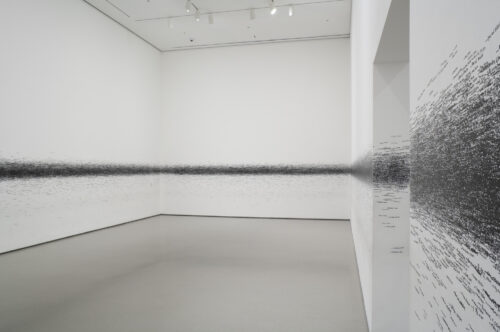
Roman Ondak
It is useful and illuminating to briefly discuss the somewhat heated debate centered around Derrida’s critique of Foucault…or at least of this book. There are valid aspects to Derrida’s arguments regards Descartes, but that was never the focus of Foucault’s history. What seems to be missed in Derrida’s reading of The History of Madness is that the most important chapter, from which I have quoted extensively, is about the transition to the Age of Reason, where the society, the state, the superstructure, actively sought to ‘silence’ madness. To confine it, but also ‘cure’ it, to ‘treat it’. To medicalize it. And this was less about epistemology than it was about the historical practices. It was the beginning of a new rationality that saw efficiency as economically beneficial, and about authority and new manifestations of repression.
The current age, the age of the internet, of digital tech, is shaping human consciousness, the Ego, in ways that are creating desire-less proles. This is an era that sits at the very end of the one that first silenced madness. The rise of ChatGPT and Grok and all the other AI functions, has conditioned users to accept the most immediate answer or explanation to anything. Curiosity is experienced as tiring. The results to queries addressed to AI means accepting the very most generalized probable answers. Often not even answers. And not infrequently wrong answers at that. The age of probably. The cleansing science of the late 1700s has morphed into a form of hyper irrationality. And I hope, in some small way, to at least suggest some threads and forces involved in what is a fascistic onanistic psychological suicide.
“The appearance of Sadism comes at a moment when unreason, emerging from a century and a half of silence, reappears not as a figure of the world, nor as an image, but as discourse and desire. And it is no coincidence that Sadism, as an individual phenomenon that bears the name of a single man, is born from and within confinement, and that confinement figures so strongly in an oeuvre ordered around images of the Fortress, the Cell, the Dungeon, the Convent, the inaccessible Island that seem to be the natural places of unreason. Neither is it a coincidence that the whole fantasy literature of madness and horror contemporary with Sade’s work takes place primarily in the high places of confinement. This sudden conversion in the late eighteenth century of the Western memory, and the possibility of finding familiar figures from the late Middle Ages, distorted and bearing new meanings, was authorised and enabled by the subsistence of the fantastic in the very places where unreason had been reduced to silence.”
Michel Foucault (Ibid)
As is often the case, a return to Freud is necessary. There is always a dialectic between the world around us, which impacts our psyche, and our psyche which continues to impact that material natural world around us.
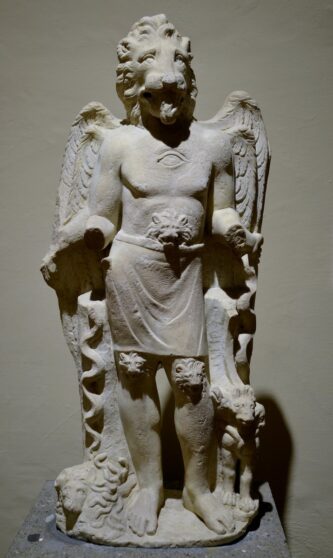
Statue found in Domitian’s villa, 1933. Lion headed man associated with Mithras cult.
“By ‘instinct’ [Trieb] is provisionally to be understood the psychical representative of an endosomatic, continuously flowing source of stimulation, as contrasted with a ‘stimulus,’ which is set up by single excitations coming from without. The concept of instinct [Trieb] is thus one of those lying on the frontier between the mental and the physical. The simplest and likeliest assumption as to the nature of instincts would seem to be that in itself an instinct is without quality, and, so far as mental
life is concerned, is only a measure of the demand made upon the mind for work.”
Sigmund Freud (An Outline of Psychoanalysis)
‘Drives’ are to our sense of self as Aevum is to our sense of time. We feel drives, and yet because they have no beginning and no end they exist in a timelessness, which they share with the unconscious. Reason as it became ‘science’ continued to look at domination, of nature and of ourself, as a good thing, even a moral thing. The silencing of madness, or aberrant emotions and impulses, made solutions more valuable. And this led logically (reasonably) to the idea of predicting results before the experiment. Science always pretends it is impartial, but of course it is not at all impartial. In fact science is usually playing with marked deck.
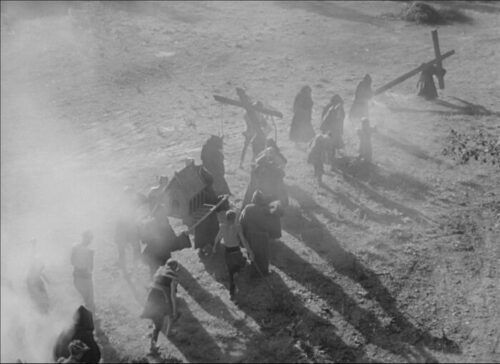
The Seventh Seal (Dr. Ingmar Bergman, 1957)
“The drive as a “demand made upon the mind for work” is typically rendered as an account of what sets the “psychic apparatus” in motion. But we should not be so quick to reduce what Freud means by “work” here to some form of automatic functioning. “Work” here can also be read as a demand for critical judgment, as an openness to an experience of the world. As a demand made upon the mind for work, the concept of the drive attempts to demarcate a frontier that is at once a kind of openness. That is, to be driven is precisely not to be biologically pre-programmed, but to be able to encounter the world as an opportunity for difference, novelty and change. The variability of the drive reflects an originary openness of mind and world, such that to be driven is to be capable of working both on the world and on oneself, and in such a way that to work on the world is to work on oneself, and equally the reverse.”
Jared Russell (Sublimation and Superego: Psychoanalysis Between Two Deaths)
To *work* on oneself, early on, by the Industrial revolution at the latest, became to dominate oneself, one’s inner life. The work then became to master one’s emotions. Which is tied to ‘improvement’ — self improvement. There was a class aspect to this. The poor are much louder than the ruling class. The ruling class govern quietly. Their brutality screams loudly but their interior orders are whispers. I remember Andrew Sarris once describing the films of Douglas Sirk, and saying the visuals screamed but the characters whispered (I paraphrase). In this new age of the ‘probable’ all classes are coming to accept non personhood. That is the appeal of transhumanism. There is a strange inexplicable connection between this attention captivity and a new passivity. Statistics suggest stark declines in carnal matters and that which exists is channeled into internet porn. Pornography as controlled tension release, anonymous, and perhaps the rise of incel culture can be viewed as a controlled self destruction. If Capitalism is in controlled demolition, then the incel is the architect of a personal erotic self destruction. (the occasional actual act of violence suggests complex tensions that will, finally, demand release). If the torture chamber was there beneath the monastery cells (metaphorically speaking), then today the lonely isolated incel sits at his screen conjuring ways to torture those who rejected him (although it is much deeper than mere rejection) but usually framed by Puritan values. Today, the militaries around the globe, but in particular the U.S. military death machine most closely resembles the Church of the 12th century. The colonial logic of Imperialism has manufactured its own Crusaders. One can see the disjointed echos of ‘crusade indulgences’ (NATO countries might well look at it this way) and ‘military orders’ (private security corporations now). And here the comic book mentality of a Pete Hegseth, with his Crusader tattoos, is not unaware of these echoes. The Christian world launched over seven crusades, most unsuccessful. But the compulsion remained. The ‘crucesignatus’, (men signed with the Cross) created a significant number of disillusioned returning fighters, men without roles in their own lands. And then in the early 1300s came the plague.
The early medieval period saw Nature through a sort of gothic grotesque lens, and through a sense of Church guidelines. Madness was in part divine and creative, and Freud saw ‘drives’ as core elements in the formation of fantasy. But the medieval Church was not a sanctuary of Reason and rationality. It was by the 13th century a place of learning, but also a place of visions and epiphanic devotions. By the late 20th century the therapeutic culture of adjustment employed terms like ‘working on yourself’ (as did groups like AA and NA and many others related to addiction and self harm etc). Do the work etc. Develop a new version of yourself. This was the near Calvinist mantra of hyper self denial. The addict becomes cloistered monk of self containment. AA advises no sex while in recovery and recovery never ends. Hi, I’m Bob, and I’m an alcoholic. The late 20th century has no places of protected learning.
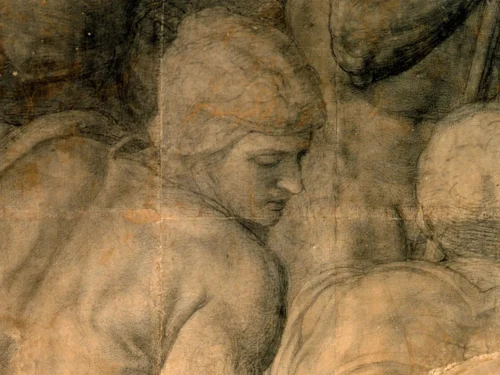
Michelangelo (drawing for soldiers of the Crucifixion, detail)
The repetition compulsion was being manifested on a spiritual level, in a sense, with these doomed expeditions. The military today is motivated by free college tuition, the GI bill, health care benefits, and job security. Over 40% (from a 2018 survey) said the main motivation was financial. But that does not tell the whole story; these numbers don’t factor in the psychological context for most Americans. The erosion of public education, that few jobs exist that provide meaning or dignity, and that the emotional landscape reflects the denuded natural landscape, the crumbling cities and poverty riddled rural enclaves. Matt Modine’s character in Kubrick’s Full Metal Jacket says “I wanted to meet interesting and stimulating people of an ancient culture… and kill them.”
“Few would dispute the claim that asylums operated along moral treatment lines provided a more humane environment than the worst of the traditional madhouses. Well, actually the French philosopher Michel Foucault and his followers would. Foucault famously dismissed ‘moral treatment’ as a form of ‘gigantic moral imprisonment’, and however exaggerated the sentiment, it contains at least a kernel of truth. The Scottish alienist and propagandist W. A. F. Browne bluntly acknowledged that: ‘There is a fallacy even in conceiving that Moral Treatment consists in being kind and humane to the insane.’ The new approach sought to transform the asylum into a ‘great moral machine’, whose goal was to ensure that ‘the impress of authority is never withdrawn, but is stamped upon every transaction’. In his own practice, Browne boasted, he sought to continue ‘the discipline and inspection exercised during active pursuits into the night, and during silence and sleep. Control may thus penetrate into the very dreams of the insane.’ The imagination run riot must be brought to heel, domesticated and civilized even in those who had lapsed into a state of deep unconsciousness.”
Andrew Scull (Ibid)
The great moral *machine*. Here already the cult of science rears its head. But Scull also adds that Foucault does not provide materialist reasons for historical change (in this case from Medieval to Classical). While not overt, certainly the end, finally, of Bubonic plague seems a pretty material reason to embrace something not too different from optimism. Also, at this point, it is worth pointing out the elevation of ‘science’ was a white person project. The ‘machine’ was a symbol of white man’s superiority, both moral and scientific. But the rise of National Socialism, and (as noted here a number of times) the fact that it was never defeated but simply absorbed into ‘western democracy’, suggests that the transition to the ‘new fascism’ can be traced back to, not just one, but several key periods.

Philipp Lohöfener, photography.
“The problem for the generation which turned twenty in the 1930s was how to fight fascism, how to fight the fascists, how to fight the different forms, the different milieux in which fascism appeared. Depending on the balance of powers, depending on the global political and economic situation, forms of struggle, the struggle against fascism between the years 1930 and 1945 was a specific kind of struggle. I think that what has happened since 1960 is characterized by the appearance of new forms of fascism, new forms of fascist consciousness, new forms of description of fascism, and new forms of the fight against fascism.”
Michel Foucault (Foucault Live)
This is partly why the narrative of quantum theory seems important. It informed the cultural revolution of the 60s. The next point would be the middle 1980s, with the full effect of Madison avenue and marketing campaigns taking effect, and the final one is the early 2000s and the internet, Silicon Valley and the onset of the digital prison.
I underscore, again, that Nazi thinkers like Schmidt and Jünger are the favorites of billionaire fascists like Peter Thiel and Alex Karp. Both who are gay and reject family. Both would fit anal/sadistic character types.
“The critique of value has made a radical break with the dichotomy between base and superstructure, not in the name of a so-called “plurality” of factors, but by basing itself on the Marxian critique of fetishism. Commodity fetishism is not a false consciousness or a mystification, but a form of total social existence, which comes before all separations between material reproduction and mental factors because it determines the very forms of thought and action. It shares these features with other forms of fetishism, such as religious consciousness. It could thus be considered as an a priori; one that is not, however, ontological, as in Kant, but historical and subject to development. This investigation into the general codes of each historical epoch also preserves, against the fragmentation introduced by the poststructuralist and postmodernist ways of perceiving the world, a unitary viewpoint. The development of this approach has only just begun, but a facet of its heuristic potential may be instanced in the way it allows the emergence of capitalism in the fourteenth and fifteenth centuries to be viewed: there is a link between the origins of a positive view of labour in monasteries throughout the Middle Ages, the “ the substitution of “abstract time” for “concrete time” (and the production of the first clocks), technological innovations and the invention of firearms; the latter was the cause of the nascent state’s enormous need for money, which powered the transformation of subsistence economies into monetary economies. Against this background it is impossible to establish a hierarchy between “ideal” factors (the concept of time, the work mind-set) and material or technological factors. Equally, there was no mere convergence of independent elements. Here, the ability to abstract and quantify seems to produce this fetishism, this a priori code, this general form of consciousness in whose collective absence the technological innovations or geographical discoveries would not have had the same impact; and vice versa.”
Anselm Jaffe (Ibid)
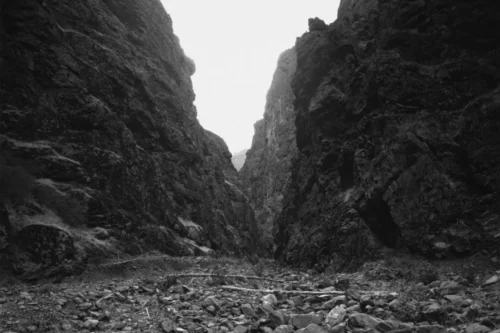
Mark Ruwedel, photography (Snake River drainage)
Jappe is looking at the work of Jean-Claude Michéa, a not very well known French thinker. But he serves to elucidate many of the problems of the left today. And this starts to exceed the subject of this post (probably).
“The nature of the religious movement which is capitalism entails endurance right to the end, to the point where God, too, finally takes on the entire burden of guilt, to the point where the universe has been taken over by that despair which is actually its secret hope. Capitalism is entirely without precedent, in that it is a religion which offers not the reform of existence but its complete destruction. It is the expansion of despair, until despair becomes a religious state of the world in the hope that this will lead to salvation. God’s transcendence is at an end.”
Walter Benjamin (Capitalism as Religion)
A final thought or two here. Jappe has a very insightful essay on Louis-Ferdinand Céline. And this particular definition of propaganda (below) feels aligned with a culture of probable. The probable, the estimate, somehow is never the ‘truth’.
“The ellipsis, the trademark of his later novels, and the absence of a real syntax produce an uninterrupted flow that never allows the reader to pause and ask himself about what he is reading. Céline does not propose to elaborate ideas, not even in a literary form, but to arouse emotions. And this is called propaganda: it is not about convincing, but about the power of suggestion. Hitler explicitly pointed this out in Mein Kampf. “
Anselm Jappe (From Celine to the Videoclip)
Celine’s racism and foul personality even offended Ernst Jünger, who met him briefly in 1941.
“Céline was never either an anarchist or a communist and, as Michel Bounan says, “the question is not to understand how a ‘libertarian’ could have gotten mixed up with the Nazis, but why someone like him ever thought it was a good idea to disguise himself as a ‘libertarian’”.
Anselm Jappe (Ibid)
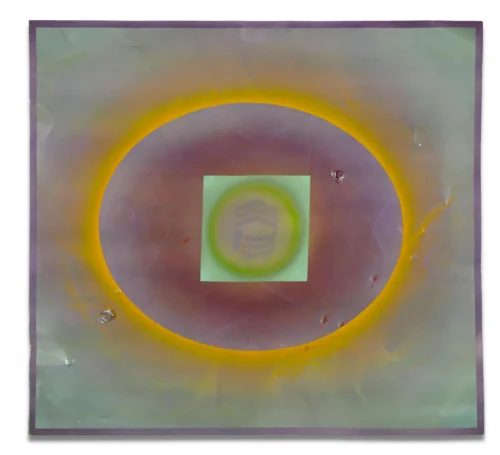
Billy Al Bengston
Benjamin’s early essay (quoted above) is Benjamin being cynical, but there is clear truth in there. And he also notes that anything repressed has ties to or literally *is* capital. And the unconscious is hell. One starts to think Nietzsche here.
Coda:
“The commodity-form is also a thought-form, as the German philosopher Alfred Sohn-Rethel (1899-1991) demonstrated. Ever since antiquity but particularly since the end of the Middle Ages, abstract and mathematical thought, as well as the abstract concept of time, have been both a consequence and a presupposition of the monetary and commodity economy, and there is no way to distinguish between what arose from the “base” and what arose from the “superstructure”.”
Anselm Jappe (The Writing on the Wall)
Quantum theory, then, is monetary physics. At least at the allegorical level. Exchange value is always there. One cannot retreat deeply enough into math to escape the commodity logic and reality. Superposition feels like a wish buried in someone’s dream of Capital. It also feels like an LSD experiment. Quantum physics is describing an economic world, or universe. Einstein famously said he didn’t want a world where God played dice. But that is what he got.
To donate to this blog, use the pay pal button at the top of the page. Donations also support The Aesthetic Resistance podcasts.
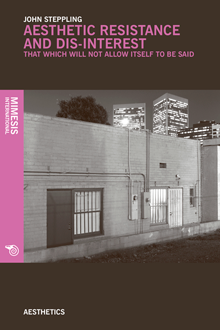
“Curiosity is experienced as tiring.” Something i’ve been trying to articulate especially as it relates to AI. Thanks John.